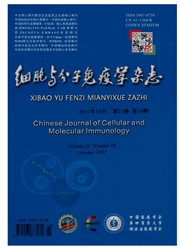

 中文摘要:
中文摘要:
目的探讨抗β2糖蛋白I(β2GPI)抗体在载脂蛋白E缺陷(ApoE-(-/-))小鼠表达动脉粥样硬化相关炎症因子和血栓相关分子过程中的作用。方法将ApoE-(-/-)小鼠实施颈动脉套环手术后,随机分为生理盐水组、100μg抗β2GPI抗体组、100μg同源对照抗体(兔IgG)组以及100μgβ2GPI/抗β2GPI抗体复合物组。各组均给以高脂饮食,且每7 d腹腔注射1次相应刺激剂,6周后处死小鼠。采用HE染色观察套环侧颈动脉阻塞情况,并以免疫组织化学染色检测套环侧颈动脉TLR4、组织因子(TF)和冯·维勒布兰德因子(vWF)的表达。采用实时荧光定量PCR检测主动脉的白细胞介素1β(IL-1β)和肿瘤坏死因子α(TNF-α)的mRNA水平。结果 HE染色结果显示抗体组阻塞最为明显,免疫组织化学染色结果显示抗体组套环侧颈动脉TLR4、TF和vWF表达上调,抗体组主动脉IL-1β和TNF-α的mRNA水平明显高于其他3组。结论抗β2GPI抗体通过上调小鼠动脉血管表达炎症因子IL-1β和TNF-α,血栓相关分子TF和vWF以及TLR4的表达,促进动脉粥样斑块形成。
 英文摘要:
英文摘要:
Objective To investigate the roles of anti-beta 2 glycoprotein I antibodies(anti-β2GPI Ab) in the expressions of atherosclerosis(AS)-related inflammatory factors and pro-thrombosis molecules in apolipoprotein E-deficient(ApoE-(-/-))mice. Methods ApoE-(-/-)mice were randomly divided into normal saline(NS) group,100 μg anti-β2GPI Ab group,100 μg homologous antibody(rabbit-IgG) group and 100 μg β2GPI/anti-β2GPI Ab complex group after silastic collars were placed around their carotid arteries by surgery. All mice were fed a high fat diet and corresponding stimuli were given through intraperitoneal injection at 7-day intervals. Six weeks later,the mice were executed. The blockage of carotid arteries of the operated side was observed by HE staining. The expressions of TLR4,tissue factor(TF) and von Willebrand factor(vWF)were detected by immunohistochemistry. The mRNA levels of interleukin-1β(IL-1β) and tumor necrosis factor-α(TNF-α) in aorta were tested by real-time quantitative PCR. Results HE staining showed that the blockage of carotid arteries in antibody group was the most obvious. The immunohistochemistry showed that the expressions of TLR4,TF and vWF in anti-β2GPI Ab group increased remarkably. Furthermore,the mRNA levels of IL-1β and TNF-α in anti-β2GPI Ab group were higher than those in the other groups. Conclusion The anti-β2GPI antibody promotes the formation of atherosclerotic plaques in mice by up-regulating the release of inflammatory cytokines IL-1β,TNF-α and thrombosis-related molecules TF,vWF and TLR4,ultimately enhancing the development of AS.
 同期刊论文项目
同期刊论文项目
 同项目期刊论文
同项目期刊论文
 期刊信息
期刊信息
